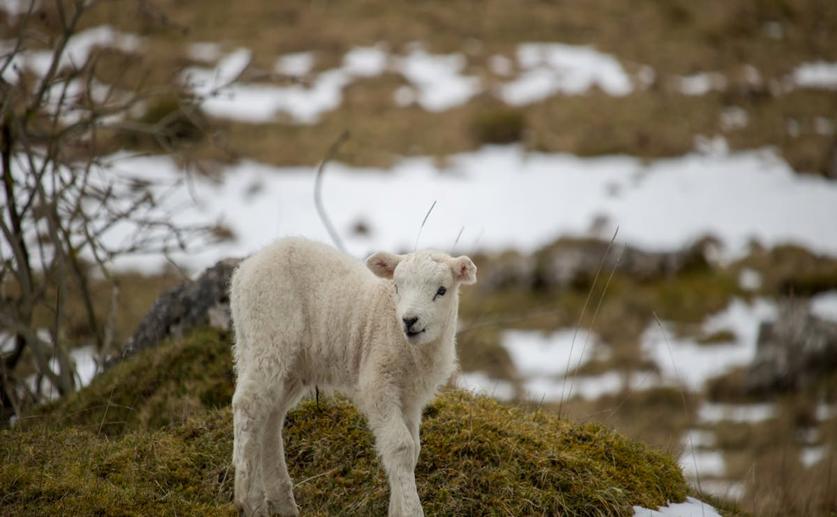Lamb Energy Use with Different Dried Banana Hay Diets

Image Source: Charlie Cantrill (photographer)
Key Findings
- In Brazil, lambs fed banana by-products showed no change in nutrient and energy intake
- Pseudostem hay was more digestible but increased methane emissions, a greenhouse gas
- Leaf hay reduced methane when lambs ate freely, and sun drying was the preferred method
In recent years, the quest for efficient and sustainable livestock feeding practices has become increasingly important. As the global demand for meat grows, so does the need for feed that is both nutritious and environmentally friendly. Researchers at the Federal University of Minas Gerais have taken a step forward in this direction by exploring how different drying methods of banana by-products affect the energy metabolism in lambs[1]. This study could potentially offer a solution to the dual challenge of waste management in banana production and the search for alternative, cost-effective feed resources for small ruminants.
The study focused on Santa Inês x Dorper lambs, a crossbreed known for its hardiness and meat quality. The researchers aimed to understand how these lambs would respond to diets that included banana leaf hay and pseudostem hay, which are residues often discarded after banana harvest. They compared the effects of two drying methods: shade drying and sun drying. The goal was to determine which method would be most effective in preserving the nutritional value of the banana by-products and, in turn, how this would impact the lambs' energy metabolism.
The experiment involved twenty lambs fed five different diets. One was a control diet consisting of Tifton 85 grass hay, while the other four included either shade-dried or sun-dried banana leaf hay or pseudostem hay. The lambs' nutrient intake and digestibility were closely monitored in metabolic cages. To assess the impact on energy metabolism, the researchers measured oxygen consumption, carbon dioxide production, methane emission, and heat production in a specialized respirometry chamber. These measurements were taken when the lambs were fed at two different levels: maintenance and ad libitum (as much as they wanted).
Interestingly, the study found that the type of banana by-product and the drying method did not significantly affect the lambs' nutrient and energy intake. However, pseudostem hay showed a higher apparent digestibility of dry matter, organic matter, and neutral detergent fiber compared to other diets. This increased digestibility, however, came with a downside—a higher energy loss in the form of methane. Methane is a potent greenhouse gas, and its production by ruminants is a concern for both environmental impact and energy efficiency in animal production.
In contrast, feeding lambs with leaf hay resulted in a significant reduction in enteric methane production when the animals were fed ad libitum. This finding is particularly relevant as it suggests that leaf hay could be a more environmentally sustainable feed component. Moreover, the study concluded that sun drying is a preferable method due to its speed, despite the fact that it did not significantly affect nutrient availability compared to shade drying.
This research ties into previous studies that have also looked at the digestibility of different forages and the nutritional requirements of small ruminants. For example, an earlier study[2] found that shade-drying improved the nutritive value of forage for ruminants by preserving higher levels of crude protein. Another study[3] assessed the metabolic energy requirements of Dorper crossbred ewe lambs, providing a benchmark for understanding the energy needs of similar breeds.
By incorporating banana by-products into lamb diets, the study offers a promising avenue for reducing waste in the banana industry and providing a cost-effective feed source. It also builds upon previous findings by demonstrating that drying methods can influence the environmental impact of ruminant diets through methane emissions[2][3].
In conclusion, the research conducted by the Federal University of Minas Gerais provides valuable insights into the use of banana by-products as animal feed. It highlights the potential benefits of pseudostem hay in terms of digestibility and the environmental advantages of leaf hay in reducing methane emissions. The study also emphasizes the practicality of sun drying as a method for preparing these by-products for animal consumption. These findings could inform future agricultural practices and contribute to more sustainable livestock production systems.
NutritionAgricultureAnimal Science
References
Main Study
1) Energy metabolism and respirometry of lambs fed sun or shade dried hays of banana crop residues.
Published 24th April, 2024
Journal: Tropical animal health and production
Issue: Vol 56, Issue 4, Apr 2024
Related Studies
Related Articles





 22nd March, 2024 | Jenn Hoskins
22nd March, 2024 | Jenn Hoskins